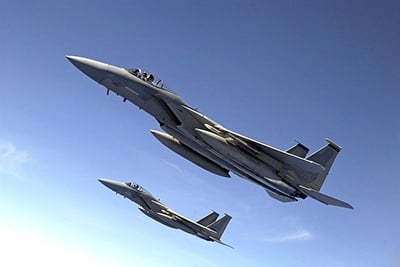 Today’s military strength is built around having the best technology, rather than simply brute force. From aircraft, battlefield vehicles and naval vessels to the kit used by soldiers, advanced equipment is central to the modern armed services.
Today’s military strength is built around having the best technology, rather than simply brute force. From aircraft, battlefield vehicles and naval vessels to the kit used by soldiers, advanced equipment is central to the modern armed services.
Sharing and delivering growing amounts of information is at the heart of these high tech machines. Evolving from simple radio communications, systems now have to collect data from sensors and cameras around the vehicle in real time, share it locally, send it back to base and allow remote operation in the case of drones. And all of this in inhospitable terrain, and potentially under enemy fire. Repairing equipment in the field often isn’t an option so it has to be rugged and reliable, and capable of lasting for long periods of service.
Due to its ability to deliver huge amounts of data at the speed of light, fibre optic cables are increasingly the choice of the armed forces, particularly as they don’t have the electrical noise footprint of copper and cannot be jammed by the enemy. However ensuring they can survive the toughest of conditions can be a challenge. Installations need to meet a number of criteria:
1 Strength
Fibre is inherently fragile so the cable surrounding it has to be able to withstand a whole range of factors. From vibration and high temperatures to air and sea pressure in planes and submarines, cables need to be strong enough to survive modern warfare. One little realised need is the fact that in many military platforms cables need to pass through substantial glands (seals) and ‘cable’ transits between different compartments and decks. These tight fitting transits can exert considerable pressure on cables, making crush resistance vital.
2 Flexibility
Conditions within military vehicles are cramped with every space taken up with vital equipment. Therefore cables need to be able to be routed in very tight spaces without damaging data transmission.
3 Lightweight
It is vital that vehicles are as light as possible, while retaining their strength and fighting capabilities. This rules overly heavy metal cable in many applications as it would slow down or reduce the ability of vehicles, such as aircraft or armoured personnel carriers to carry out their role.
4 Resistant
From dust and heat to sea water corrosion, chemical spills and even radiation exposure, cables need to be able to withstand a wide range of substances.
5 Repairable
In the field running repairs are often needed to keep vehicles functioning, often many miles from specialist help. Cables have to be simple to handle and install by crews themselves where necessary, without the need for complex or unwieldy equipment.
At PPC we’re proud to say that our Miniflex range of fibre cables and microducts have been installed for many years in military vehicles that are in service around the world. Our products are protecting the electronic systems of over $12.5 billion of fighter jets, in use within ships and armoured personnel carriers, as well as being selected for the European Space Agency’s forthcoming Mars mission. Through Miniflex’s combination of strength, lightness and flexibility it provides the perfect protection for vital military systems – now and in the future.



Comments